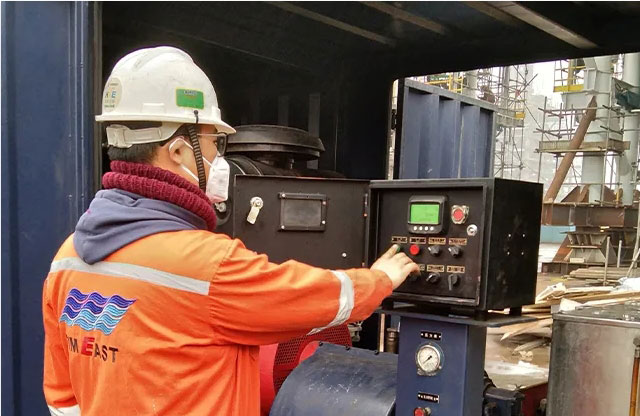What is Chemical Cleaning in Piping?
Introduction
In the realm of industrial processes and fluid transportation, maintaining the efficiency and reliability of piping systems is paramount. Over time, these vital networks can accumulate deposits, contaminants, and scale, leading to reduced performance, increased energy consumption, and potential equipment damage. To combat these issues, the practice of chemical cleaning in piping systems emerges as a powerful solution. In this article, we will delve into the intricacies of chemical cleaning, its purpose, benefits, and the processes involved.
Understanding Chemical Cleaning
Chemical cleaning, also known as chemical flushing or circulation cleaning, refers to the systematic process of removing unwanted deposits, contaminants, and scale from the internal surfaces of piping systems. It involves the use of specialized cleaning agents and techniques tailored to address the specific nature of the deposits and contaminants encountered. By employing chemical cleaning, industries can restore the optimal functionality and extend the lifespan of their piping systems.
The Need for Chemical Cleaning
Over time, various factors contribute to the accumulation of deposits in piping systems. These factors include the properties of the transported fluids, the temperature and pressure conditions, the quality of the water used, and the nature of the materials comprising the pipes. Consequently, deposits such as rust, scale, biofilms, and other contaminants gradually form on the inner surfaces of the piping system.
The presence of these deposits can have detrimental effects on the system's performance. They can restrict the flow of fluids, increase pressure drop, promote corrosion, and provide a favorable environment for microbial growth. Consequently, these issues lead to decreased efficiency, increased energy consumption, and an elevated risk of equipment failure.
The Chemical Cleaning Process
Chemical cleaning involves a systematic and carefully orchestrated series of steps to ensure the successful removal of deposits and contaminants. While the specifics may vary depending on the characteristics of the piping system and the types of deposits present, the general process typically includes the following stages:
1. Pre-Cleaning Assessment
Before commencing chemical cleaning, a thorough assessment of the piping system is conducted. This assessment involves inspecting the system's design, materials, operating conditions, and the nature of the deposits. Understanding these factors helps in selecting the appropriate cleaning agents, determining the cleaning techniques, and ensuring the safety of the process.
2. Selection of Cleaning Agents
Based on the assessment, suitable cleaning agents are chosen to effectively dissolve and remove the specific deposits and contaminants present in the piping system. The selection of cleaning agents depends on factors such as the composition of the deposits, the material of the pipes, and the compatibility with other system components.
3. Preparation of Cleaning Solution
The cleaning agents are mixed with water or other solvents to create a cleaning solution of the desired concentration. The solution's pH and temperature may also be adjusted to optimize the cleaning process.
4. Flushing and Circulation
The cleaning solution is introduced into the piping system through specific access points, such as flush points, vents, or drain points. It is then circulated throughout the system, ensuring that all areas are adequately treated. The circulation can be achieved by using pumps, pressure differences, or other mechanical or hydraulic methods.
5. Contact Time
The cleaning solution is allowed to remain in contact with the deposits and contaminants for a predetermined period. This contact time ensures that the cleaning agents have sufficient opportunity to dissolve and dislodge the unwanted substances.
6. Mechanical Agitation (If Required)
In some cases, mechanical methods such as brushing, scraping, or using specialized cleaning tools may be employed to enhance the cleaning process. Mechanical agitation helps dislodge stubborn deposits that may require additional assistance to remove completely.
7. Flush Out and Rinse
After the desired contact time, the cleaning solution, along with the dissolved deposits and contaminants, is flushed out of the piping system. The system is then thoroughly rinsed with clean water to remove any residual cleaning agents or loosened particles.
8. Inspection and Validation
Once the cleaning process is complete, a post-cleaning inspection is conducted to assess the cleanliness and effectiveness of the chemical cleaning. Various inspection methods, such as visual examination, sampling, or non-destructive testing, can be employed to ensure the desired level of cleanliness has been achieved.
Benefits of Chemical Cleaning
Chemical cleaning in piping systems offers a multitude of benefits, including:
1. Improved System Performance
By effectively removing deposits and contaminants, chemical cleaning restores the original diameter of the piping system, ensuring optimal flow rates, reduced pressure drop, and enhanced overall performance. This leads to improved efficiency, energy savings, and increased productivity.
2. Prevention of Corrosion
Deposits and contaminants can accelerate corrosion processes within piping systems. By removing these obstructions, chemical cleaning mitigates the risk of corrosion, extending the lifespan of the system and reducing the need for costly repairs or replacements.
3. Enhanced Reliability and Longevity
Chemical cleaning helps maintain the structural integrity of piping systems by preventing the accumulation of harmful substances. This, in turn, enhances the reliability and longevity of the system, reducing downtime and improving operational efficiency.
4. Compliance with Regulatory Standards
In many industries, compliance with regulatory standards and guidelines is crucial. Chemical cleaning aids in meeting these requirements by ensuring the cleanliness and integrity of the piping system, leading to a safer and more compliant operational environment.
https://contgpt.com
Conclusion
Chemical cleaning in piping systems plays a vital role in maintaining their performance, efficiency, and longevity. By effectively removing deposits, contaminants, and scale, industries can optimize their operations, reduce costs, and mitigate the risk of system failures. Understanding the process, benefits, and importance of chemical cleaning empowers organizations to make informed decisions regarding the maintenance and care of their piping systems. Embracing the power of chemical cleaning unlocks a world of possibilities for industries across diverse sectors.
More info please click here.
178
0
0
Next: None



Comments
All Comments (0)